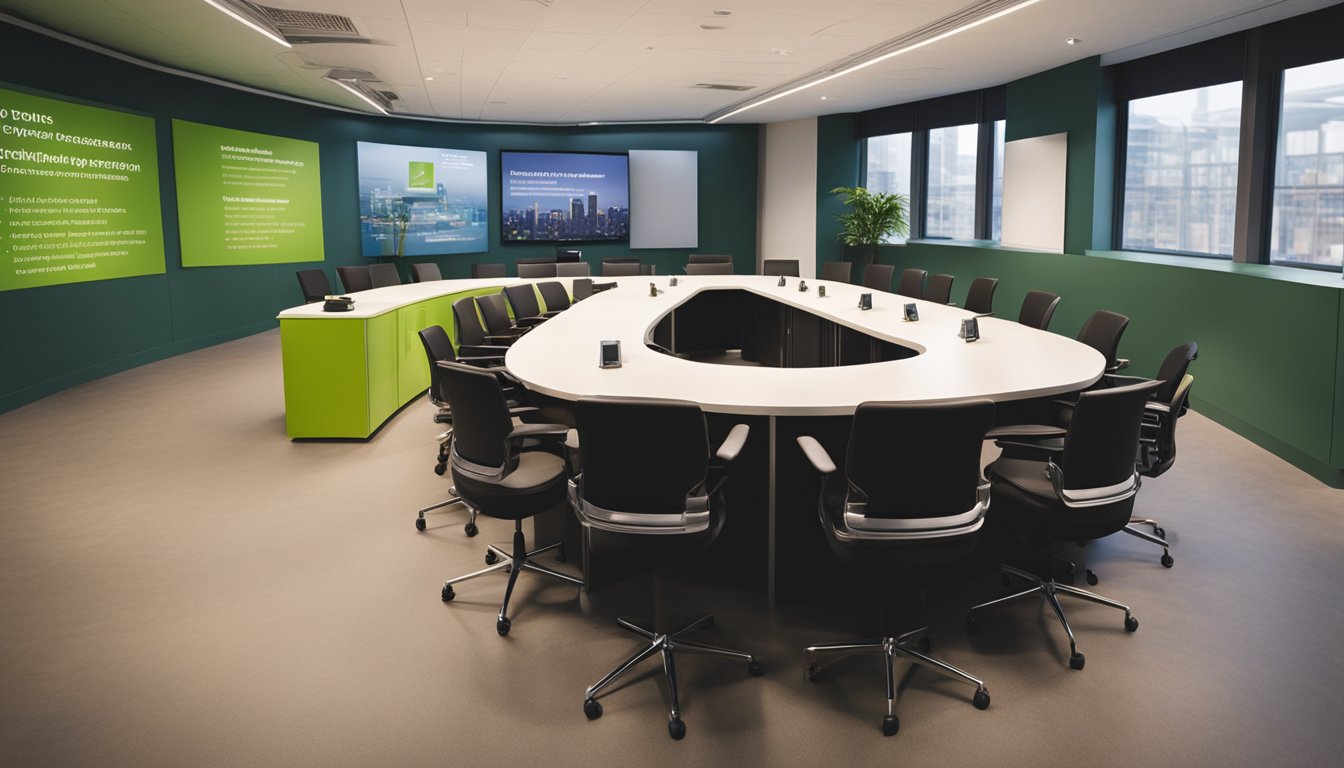Late updated: 28 Nov 2024 13:11
Written by: Amber Collins
Eco-Friendly Meeting Tips For UK Businesses: A Guide to Sustainable Practices
In today's business world, adopting eco-friendly practices isn't just a feel-good initiative; it's a strategic necessity. As UK businesses navigate this shift, integrating sustainability into even routine meetings can be a pivotal step. By embracing eco-friendly meeting tips, companies not only contribute to environmental preservation but also enhance their corporate image and operational efficiency.

Our focus is on practical solutions that address the environmental impact of business meetings. This includes selecting venues with sustainable amenities and optimizing the use of renewable resources. Simple adjustments, like using virtual platforms and efficient energy systems, can significantly reduce carbon footprints.
The challenge lies in balancing business needs with sustainability goals. However, with thoughtful planning, it's possible to hold effective meetings that honour both. Our strategies aim to inspire UK businesses to lead the way in green meeting practices.
Key Takeaways
- Eco-friendly practices improve corporate image and efficiency.
- Sustainable venues and renewable resources reduce meetings' carbon footprints.
- Thoughtful planning balances business needs and sustainability goals.
Planning Eco-Friendly Meetings

In our mission to host eco-friendly meetings, there are several impactful strategies we can adopt. By focusing on sustainable venue selection, digital communication practices, and energy conservation measures, we can significantly reduce the environmental footprint of our business events.
Selecting Sustainable Venues
Choosing the right venue is crucial for reducing the carbon footprint of a meeting. We aim to select venues with LEED certification—a recognised standard for green buildings. These venues ensure that sustainability is a priority in their operations, from energy efficiency to reduced waste management.
Venues with strong environmental policies often use renewable energy sources. These locations support our aim to minimise environmental impact, promoting responsible event planning. Additionally, supporting such venues can encourage others in the industry to prioritise sustainability.
Proximity to public transport is also vital. This can lower emissions from attendee travel. Venues located conveniently reduce the need for private cars, helping to cut down the overall environmental footprint of our meetings.
Incorporating Digital Communication
Adopting digital communication is essential for sustainable meeting planning. By opting for digital invitations and materials, we can significantly minimise paper usage. This reduces waste and the energy associated with printing and distribution.
Utilising digital platforms for communication allows us to maintain connections with participants in a more environmentally friendly way. Embracing video conferencing and online collaboration tools eliminates the need for physical travel, thereby cutting down on carbon emissions.
Transitioning to cloud-based project management tools ensures we maintain efficient workflows while reducing our reliance on physical storage and resources. This shift not only promotes sustainability but also enhances flexibility and accessibility for our team.
Adopting Energy Conservation Practices
Implementing energy conservation practices during meetings is essential for reducing their environmental impact. We focus on using energy-efficient lighting and equipment, like LED lights and Energy Star appliances, to lower energy consumption.
Turning off devices when not in use is a simple yet effective strategy. Encouraging attendees to unplug their devices when idle helps save energy and emphasises the importance of conservation efforts.
Utilising spaces with natural lighting can also contribute to energy savings. By planning events during daylight hours and choosing venues with large windows, we can make the most of natural light, thereby decreasing our reliance on artificial lighting.
Implementing Sustainable Resources

In our journey to host eco-friendly meetings, we can make impactful choices by focusing on recycling and reused materials, prioritising local produce, and encouraging water conservation. These actions are vital in reducing our environmental footprint.
Focusing on Recycling and Reused Materials
By integrating eco-friendly materials into our events, we significantly lessen waste. Utilising recycled paper for meeting notes and agendas is one method. Avoid single-use plastics by opting for reusable or compostable alternatives for utensils and plates.
Decor can be borrowed or rented to minimise waste. Items like banners and signs should be designed for multiple uses. Providing clearly marked recycling bins encourages waste separation and proper disposal.
It's important that we source materials responsibly. Opt for suppliers who prioritise sustainability in their operations and can provide evidence of their environmental commitment.
Choosing Local Produce
Selecting local produce reduces our carbon footprint by cutting down on transportation emissions. Using seasonal ingredients from nearby sources supports local farmers and ensures fresh, high-quality meals. This practice not only benefits our environment but also strengthens our community ties.
Menus should highlight locally sourced items. We can consider partnering with caterers who share our sustainability goals. This collaboration ensures meals are prepared with in-season fruits, vegetables, and other locally available items.
Our menu can include plant-based dishes, which typically have a lower environmental impact than meat-heavy options. Plant-based meals can enhance our sustainability efforts while offering diverse culinary experiences.
Encouraging Water Conservation
Implementing water-saving measures is crucial for sustainable meetings. Water dispensers can replace individual bottled water, reducing plastic waste. Encourage attendees to bring their own bottles for refills.
Install facilities equipped with low-flow taps and toilets to minimise water usage. Signage reminding guests to conserve water can reinforce this practice.
Choosing venues aligning with our water conservation goals is important. Explore options like rainwater harvesting systems or eco-friendly cleaning practices. This choice further strengthens our commitment to sustainability and ensures we lead by example.
Frequently Asked Questions

Eco-friendly meetings are an integral part of sustainable business practices. By focusing on waste reduction, carbon footprint minimisation, and sustainable planning, businesses can lead by example and promote environmental stewardship.
What are effective strategies for reducing waste at company events?
We can start by using digital invitations and tickets to eliminate paper waste. Encouraging attendees to bring reusable water bottles and providing recycling stations also helps. Opting for minimal packaging and sourcing catering from local providers reduces waste significantly.
How can businesses in the UK minimise their carbon footprint when hosting meetings?
Selecting venues with strong eco-friendly credentials is essential. Using public transport or carpooling options for attendees can make a big difference. Moreover, incorporating virtual components into events can reduce the need for travel altogether.
What are some innovative ideas for sustainable corporate events?
Implementing a virtual reality component can transform event presentations while minimising physical material usage. We can also include interactive workshops focusing on sustainability. Providing plant-based catering and eco-friendly giveaways further enhances the initiative.
What steps can be taken to ensure a meeting or event is environmentally sustainable?
First, evaluate and select venues with clear sustainability policies. Ensuring energy-efficient lighting and equipment should also be a priority. Offering digital materials rather than printed copies significantly contributes to sustainability goals.
How can sustainability be integrated into event planning and execution?
Incorporating sustainability from the outset of planning is crucial. Engaging suppliers who share our eco-friendly values is important. Using sustainable materials for décor and prioritising renewable energy resources assures our commitment remains steadfast at each stage.
What are some creative themes for hosting a 'Sustainability Week' in the workplace?
Introducing initiatives like 'Zero Waste Day' or 'Green Transport Day' can be engaging for staff. Hosting workshops on topics such as "Energy Efficiency" or "Sustainable Living" nurtures an eco-conscious culture. A focus on local conservation projects could also inspire ongoing community involvement.
